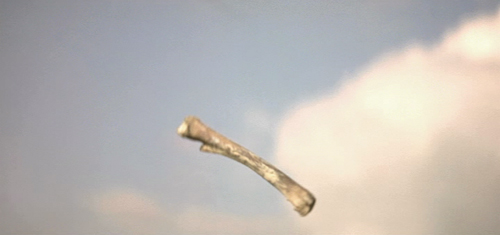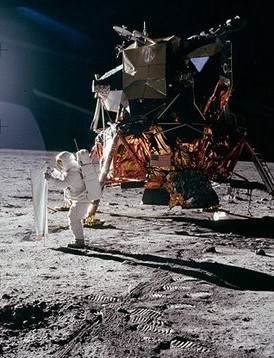The death of Neil Armstrong in August prompted no end of tributes invoking heroism, patriotism, vision, courage, valor, and all sorts of other abstractions. Understandably so. Armstrong’s giant leap was in fact the first baby step in one species’ attempt to leave home. Less in the news, though, was a more concrete matter: hard science.
The Apollo program began as symbolic one-upmanship. In May 1961, President Kennedy, in high Cold War mode, stood before a joint session of Congress and declared, “I believe this nation should commit itself to achieving the goal, before this decade is out, of landing a man on the moon and returning him safely to the Earth.” The mythology, not without some basis in truth, is that what followed was a sort of Space Race to the Pole, with the United States and the Soviet Union eventually assuming the roles of Amundsen and Scott, respectively (except for the getting-there-second-and-then-dying part).
For the victor, though, the Apollo missions weren’t all golf balls and kangaroo hops. They also included a fair number of scientific experiments. On Apollo 11, one such experiment involved Armstrong unfurling an aluminum foil from a reel, fastening it to a telescopic pole that he’d planted in about four inches of Moon soil, and positioning it so that it faced the Sun. Seventy-seven minutes later Armstrong removed the foil from the pole, refurled it, and slipped it—along with the fate of the universe—into a Teflon bag.
 The purpose of the Solar Wind Composition Experiment was, as its name implies, to collect samples of the solar wind—the subatomic particles that are constantly streaming from the Sun but, because of our atmosphere, never reaching Earth. Among the particles that fastened themselves to the foil was deuteurium, an isotope of hydrogen that has one neutron in the nucleus instead of none. The team at the Universitat Bern that analyzed the Apollo 11 foil over the next couple of years found that the abundance of deuterium from the Sun, which in turn would reflect the abundance of deuterium in the universe, was one-tenth what physicists had been estimating.
The purpose of the Solar Wind Composition Experiment was, as its name implies, to collect samples of the solar wind—the subatomic particles that are constantly streaming from the Sun but, because of our atmosphere, never reaching Earth. Among the particles that fastened themselves to the foil was deuteurium, an isotope of hydrogen that has one neutron in the nucleus instead of none. The team at the Universitat Bern that analyzed the Apollo 11 foil over the next couple of years found that the abundance of deuterium from the Sun, which in turn would reflect the abundance of deuterium in the universe, was one-tenth what physicists had been estimating.
This finding began to assume greater cosmic significance a few years later, when the University of Chicago physicist David Schramm and his students determined that deuterium could only be destroyed in stars rather than created (as other elements could be). Therefore, all the deuterium in the universe today must have been present in the earliest universe. Even more of it could have been present then, and presumably was, only to be destroyed later. But we can say with certainty that the present amount was at least the primordial amount.
That amount, in turn, provides an insight into how much matter in total would have existed in the earliest universe. The greater the density of the primordial soup, the lower the survival rate of the deuterium. The lower the density of the soup, the greater the survival rate of the deuterium. So if we know at least how much deuterium existed in the earliest universe, then we know the density of the primordial soup at most.
And because we know the universe is expanding, we also know that the density of matter in the universe will determine its fate. Is the universe sufficiently dense to slow the expansion until it eventually reverses itself, and the universe collapses? Or insufficiently dense to stop the expansion, and the universe expands forever?
Deuterium’s verdict, delivered through the measure of cosmic density, was that the universe contained only one-tenth the amount of matter necessary to reverse the expansion.
And there you have it: the fate of the universe.
Actually, no. Schramm, for one, didn’t like that answer. He was among the leading proponents—probably the leading proponent—of the movement to unite the physics of the very small, like deuterium, to the physics of the very big, like the fate of the universe. But he also argued that the density of the universe had to be “just right”—just sufficient to neither collapse nor expand. Just sufficient to eventually bring the expansion to a stop, and no more. He had the math to back it up: By extrapolating calculations of the possible density backward to the first fraction of a fraction of a second, he found that any deviation from “just right” would have long ago resulted in the destruction of the universe, either through collapse or hyperexpansion.
His argument got a significant potential boost when astrophysicists began to realize that the measure of the density was taking into account only protons and neutrons, collectively known as baryons. The discovery of convincing evidence for the existence of nonbaryonic matter—what’s become known as dark matter—by the end of the 1970s reopened the issue. The question then became: Does the universe have enough baryonic and non-baryonic matter to slow the expansion, or not?
That’s the question that two rival teams of astronomers raced to find in the 1990s, culminating in the discovery that they’d both made a wrong assumption. They had set out to answer the question How much is the expansion slowing down? Instead, the question should have been How much is the expansion speeding up? Whatever it is that’s causing the acceleration is what we now call dark energy.
Put dark matter, dark energy, and good old baryonic matter together, and the density of the universe is indeed just right, sort of. Not in the sense that the fate is eternal equipoise. From all present evidence, the expansion of the universe will continue to accelerate forever under the influence of dark energy. But Schramm was correct in arguing that the density couldn’t be anything other than just right. He just didn’t know that he needed to take dark energy into account in order to measure that density.
 Fate—not of the universe, but of the more personal variety—was unkind to Schramm: He died in December 1997, just weeks before the announcement of the discovery of dark energy. But fate has been unkind to the rest of us, too. Neil Armstrong’s small step was the start of an epic coming-of-age tale, the opening sentence in the ultimate Bildungsroman. And what’s the first thing he found? How the story ends.
Fate—not of the universe, but of the more personal variety—was unkind to Schramm: He died in December 1997, just weeks before the announcement of the discovery of dark energy. But fate has been unkind to the rest of us, too. Neil Armstrong’s small step was the start of an epic coming-of-age tale, the opening sentence in the ultimate Bildungsroman. And what’s the first thing he found? How the story ends.
* * *
For some of the scientific background in this post, I’m grateful to The Shadows of Creation: Dark Matter and the Structure of the Universe, by Michael Riordan and David Schramm.

I suspect that this too is an incomplete story; and just when we think all the pieces have fallen in place…, we discover our net wasn’t fine enough….
Bildungsroman, anyone?